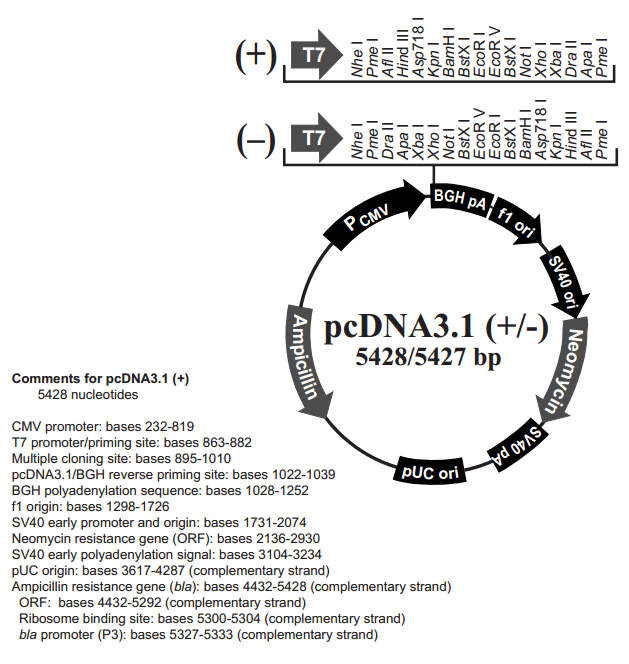pcDNA3.1(+) 载体
| 质粒类型: | 哺乳动物表达载体 |
|---|---|
| 启动子: | CMV |
| 表达水平: | 高 |
| 克隆方法: | 多克隆位点,限制性内切酶 |
| 载体大小: | 5428 bp (查看载体序列) |
| 5' 测序引物: | pcDNA3.1-F:CTAGAGAACCCACTGCTTAC |
| 3' 测序引物: | pcDNA3.1-R (BGH-R):TAGAAGGCACAGTCGAGG |
| 载体抗性: | Ampicillin (氨苄青霉素) |
| 筛选标记: | Neomycin / G418 |
pcDNA3.1(+) and pcDNA3.1(-) are 5.4 kb vectors derived from pcDNA3 and designed for high-level stable and transient expression in mammalian hosts. High-level stable and non-replicative transient expression can be carried out in most mammalian cells. The vectors contain the following elements:
- Human cytomegalovirus immediate-early (CMV) promoter for high-level expression in a wide range of mammalian cells
- Multiple cloning sites in the forward (+) and reverse (-) orientations to facilitate cloning
- Neomycin resistance gene for selection of stable cell lines
- Episomal replication in cells lines that are latently infected with SV40 or that express the SV40 large T antigen (e.g. COS-1, COS-7). The control plasmid, pcDNA3.1/CAT, is included for use as a positive control for transfection and expression in the cell line of choice.
This pcDNA™3.1(+)vector is designed for high-level, constitutive expression in a variety of mammalian cell lines. It contains a Geneticin® selectable marker and a forward-orientation multiple cloning site.
The pcDNA™3.1 Expression Vector Family
Three untagged versions of pcDNA™3.1 (available separately), each with a different selectable marker (Geneticin®, Zeocin™, or Hygromycin), are for use alone or in co-transfections. All three vectors offer the following features:
• Cytomegalovirus (CMV) enhancer-promoter for high-level expression
• Large multiple cloning site in either forward (+) or reverse (-) orientations
• Bovine Growth Hormone (BGH) polyadenylation signal and transcription termination sequence for enhanced mRNA stability
• SV40 origin for episomal replication and simple vector rescue in cell lines expressing the large T antigen (i.e., COS-1 and COS-7)
• Ampicillin resistance gene and pUC origin for selection and maintenance in E. coli


